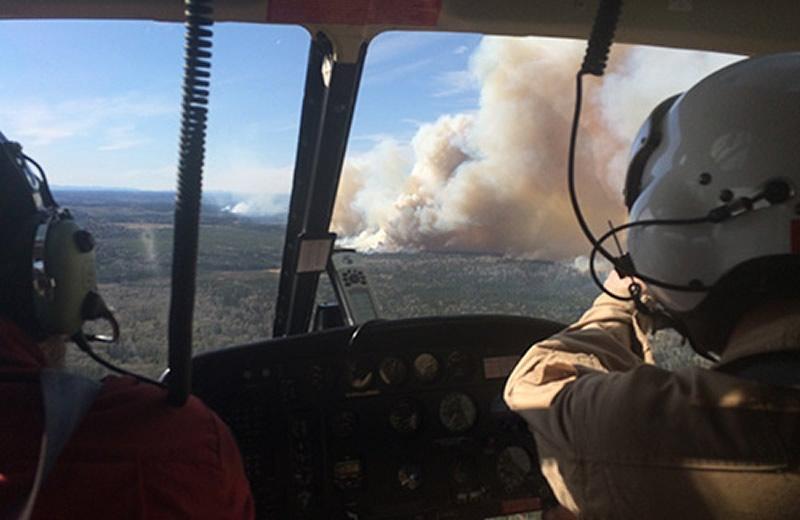To shed some light on a topic that is so often out of view, occurring at the level of tiny particles, I spoke with air quality meteorologist Gail Roth. She took me through a day in the life of someone who spends a lot of time amidst tiny particles with big health impacts!
How do we measure air quality?
The Ministry of Environment has two types of monitors, continuous and non-continuous, that are set up in communities all over B.C. We monitor all sorts of pollutants, including sulphur dioxide, nitrogen oxides, and more.
Because it's the air pollutant that most often exceeds provincial objectives, a primary area of concern is particulate matter pollution – the tiniest of particles in the air that can get stuck deep in our lungs. These are called PM2.5 – particulate matter (PM) that is 2.5 micrometres or smaller in diameter. For comparison, a human hair is approximately 60 micrometres in diameter. PM2.5 is largely generated from combustion sources (e.g., vehicles, residential wood burnings, industrial processes).
We also monitor PM10 (particulate matter that is smaller than 10 micrometres). These larger particles are mostly caused by big particles like road dust, wood dust, or pollen being broken down.
In both cases, we measure how many of these particles there are in one cubic metre of air. You'll see this reported as micrograms per metre cubed: µg/m³.
What is an air quality advisory?
The provincial objective for PM2.5 levels in a 24-hour period is 25 µg/m³. When a community gets above or close to this level, we issue an air quality advisory. This lets people know that their breathing may be affected and that they should be taking action to protect their health and reduce their emissions. The annual objective, which we use to monitor long term PM2.5 levels, is 8 µg/m³.
The provincial objective for PM10 levels in a 24-hour period is 50 µg/m³. When a community gets above or close to this level, we issue a dust advisory.
If there's a forest fire in your area, you may also see a smoky skies advisory. Although specific smoke conditions might change because of wind, fire behaviour, and temperature, a smoky skies advisory in your area means you can expect higher levels of particulate matter pollution.
What actions can I take to protect myself during these advisories?
We include these actions right in the advisories, so they can be a helpful tool in protecting your health. The overarching goal of these actions is to reduce your exposure to the poor air. Some specific actions include:
- Avoid roads with heavy traffic and areas with wood smoke
- Reduce or stop physical activity if breathing becomes difficult
Further actions, including staying indoors and running air cleaners, may be needed for those who are more sensitive, like seniors, children, and people with underlying medical conditions.
What else do air quality meteorologists do?
In addition to monitoring air quality and issuing public reports and advisories, there are two other main parts to our work:
- Technical reviews: As an example, when an industry applies for a permit for a project that might have air pollution emissions, we review the application and evaluate its potential impact on air quality in the local community and surrounding area.
- Supporting local airshed management groups: We help to start these groups and translate technical air quality information for them. Local members drive the groups and we’re a resource for them, providing support on the science side.
Where can I learn about advisories in my community?
I'd encourage everyone to visit bcairquality.ca. Whenever an advisory is in place, it will appear as a link on the homepage. Even if there's no advisory, you can still find current air quality conditions for where you live as well as great resources.
More information
Do you have respiratory sensitivities or want to take extra precautions during wildfire smoke events?
There is a growing body of evidence to suggest that portable air cleaners (equipped with HEPA filters or electrostatic precipitators) are effective at reducing indoor particulate matter concentrations and the associated health effects during short smoke events.
Be sure to research products before purchasing a portable air cleaner! Learn about the type of unit you're purchasing and the proper sizing for your space. On these devices, you'll notice a number called the clean air delivery rate (CADR) - if you're concerned about wildfire smoke, the CADR rating for tobacco smoke is the most relevant to look at.
When using a portable air cleaner, limit the entry of outdoor air. Keep in mind when you're indoors and using a portable air cleaner, however, that there can be risks from increased heat and indoor-generated air pollutants.
A version of this article was originally published in the summer 2017 issue of Healthier You magazine. Read the full issue – all about healthy lungs – on ISSUU!














Comments